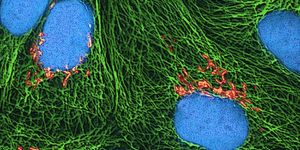Undiscovered Tunnels from Bone Marrow To Brain
Bone marrow is the soft sponge-like tissue found in the center of most bones. The bone marrow produces 200 billion new white blood cells, red blood cells, and platelets every day. These cells need to be created in high number due to the turn over rate of 10 days for platelets, 120 days for red blood cells, and only a few hours to a few days for white blood cells. White blood cells are essential immune cells involved in healing injuries and fighting off infection. According to a new study published in Nature Neuroscience tiny tunnels run from skull bone marrow to the lining of the brain, providing a direct route for immune cells.

The recent study from researchers at Harvard Medical School and Massachusetts General Hospital in Boston, led by Dr. Matthias Nahrendorf, used state-of-the-art tools and cell-specific dyes in mice to distinguish if immune cells traveled to damaged brain tissue from bone marrow in the skull or a large legbone, the tibia. The research focused on neutrophils arriving at the site of injury after the tissue is damaged by stroke or meningitis. Results showed that during stroke the skull was more likely to provide neutrophils than the tibia, while during a heart attack the skull and tibia provided equal amounts of neutrophils to the heart. Comparison of stored neutrophils in the bone marrow of the tibia and skull hours after stroke showed that the bone marrow had lower numbers, suggesting it released many more cells to the site. These results indicate that bone marrow from various locations may communicate in some way to dictate the response to injured or infected tissues.
To determine how these neutrophils arrive at the injured tissue advanced imaging techniques were utilized and revealed tiny channels that connected directly from the bone marrow of the skull to the outer lining of the brain. These channels were found in both mice and human skulls, as well as the tibia. "We always thought that immune cells from our arms and legs traveled via blood to damaged brain tissue. These findings suggest that immune cells may instead be taking a shortcut to rapidly arrive at areas of inflammation," said Francesca Bosetti, Ph.D., program director at the NIH's National Institute of Neurological Disorders and Stroke (NINDS), which provided funding for the study. "Inflammation plays a critical role in many brain disorders, and it is possible that the newly described channels may be important in some conditions. The discovery of these channels opens up many new avenues of research." Further research will examine other types of cells that may travel through the tunes and the role they may play in health and disease.
To learn more about bone marrow watch the video below!
Sources: Nature Neuroscience, Medical News Today








